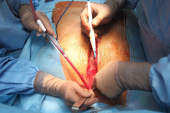LAAO During Cardiac Surgery May Help, Even in AF’s Absence
While awaiting more definitive RCTs, it would be reasonable to exclude the LAA in some of these patients, one expert says.

Performing left atrial appendage occlusion (LAAO) in patients undergoing cardiac surgery may be beneficial even in the absence of preexisting atrial fibrillation (AF), a meta-analysis suggests.
Though adjunctive LAAO was not associated with a change in the risk of postoperative AF, the risk of cerebrovascular accidents was lower at 5 years with versus without the added step, according to researchers led by Massimo Baudo, MD (Lankenau Institute for Medical Research, Wynnewood, PA).
Survival at 4 years also was slightly better if the appendage was excluded during the initial operation, they report in a study published online recently in Circulation: Cardiovascular Interventions.
The findings, which should be considered hypothesis-generating, support the need for a large RCT to confirm the apparent benefits in patients without AF, they say, noting that more definitive answers await completion of the LeAAPS, LAA-CLOSURE, and LAACS-2 trials.
Baudo told TCTMD that the intention with the meta-analysis was not to provide guideline-changing results but rather to review the evidence and “set important questions to evaluate in order to determine patients who would benefit the most from left atrial appendage occlusion without AF.”
Commenting for TCTMD, cardiac surgeon Bobby Yanagawa, MD, PhD (St. Michael’s Hospital, Toronto, Canada), said this meta-analysis is “a move in the right direction,” setting the stage for the ongoing prospective trials.
In the meantime, “for surgeons, the message is that left atrial appendage occlusion is a reasonable thing to do for their patients, particularly if they are at high risk of developing atrial fibrillation,” he said. “But there's not a clear signal one way or the other. It would also be reasonable not to perform it.”
Indeed, Baudo said, the decision should be made on a case-by-case basis, with consideration not only of a patient’s stroke risk but also of other factors, like heart failure status, diastolic function, and suitability for long-term oral anticoagulation.
Previously, the LAAOS III trial showed that prophylactic LAAO during cardiac surgery lowered the risk of stroke in patients who already had AF going into the operation, leading to strong recommendations in favor of the practice in guidelines, but there is a lack of similarly conclusive evidence when patients have normal sinus rhythm.
LAAO did not influence the risk of postoperative AF (risk ratio 1.05; 95% CI 0.86-1.28), but the rate of cerebrovascular accidents (the primary endpoint) was lower at 5 years when the added procedure was performed (4.3% vs 6.8%; HR 0.65; 95% CI 0.45-0.94).
Survival was not significantly different between the LAAO and no-LAAO groups over the entire follow-up (HR 0.80; 95% CI 0.63-1.02), but a landmark analysis at 4 years suggested a significant advantage for excluding the appendage (89.6% vs 86.0%; P = 0.041).
Yanagawa said he’s not surprised to see a lower risk of stroke in the LAAO group, adding that he expects to see that finding supported once the ongoing RCTs are completed. “If you look at our patients, 30% of them are going to get postoperative atrial fibrillation and some are going to have a stroke. And this is a subset of patients who are at risk of developing atrial fibrillation for the rest of their lives,” he said. “So if you remove the primary source of thromboembolism, that being the left atrial appendage, it makes sense . . . that you're going to have lower stroke rates.”
Overall, he said, “the fact that we are studying this is going to be a great benefit to our patients moving forward.”
In an accompanying editorial, Mark Mills, MBChB (Liverpool John Moores University and Liverpool Heart and Chest Hospital, England), and colleagues note some limitations of the meta-analysis, including the fact that only 17% of the patients came from RCTs and the rest came from retrospective studies, which are susceptible to biases and residual confounding. In addition, there was a lack of information on patients’ baseline cardiovascular risk—using the CHA2DS2-VASc score or some other tool—for most participants and on the types of antithrombotic therapy administered.
Mills et al agree that while waiting for the results of the randomized trials, the decision about LAAO during cardiac surgery should be individualized.
“Surgical LAAO may be justifiable in those meeting the strict inclusion and exclusion criteria of the two RCTs included in the meta-analysis by Baudo et al, although these studies are by no means conclusive due to their small sample sizes,” they write. “In those not meeting these criteria, enrollment into one of the aforementioned RCTs, if eligible and accessible, is preferable.”
Todd Neale is the Associate News Editor for TCTMD and a Senior Medical Journalist. He got his start in journalism at …
Read Full BioSources
Baudo M, Sicouri S, Yamashita Y, et al. Stroke prevention with prophylactic left atrial appendage occlusion in cardiac surgery patients without atrial fibrillation: a meta-analysis of randomized and propensity-score studies. Circ Cardiovasc Interv. 2024;17:e014296.
Mills MT, Kirmani BH, Lip GYH. Left atrial appendage occlusion in patients without atrial fibrillation undergoing cardiac surgery: the evidence is mounting. Circ Cardiovasc Interv. 2024;17:e014633.
Disclosures
- Baudo and Mills report no relevant conflicts of interest.





Comments